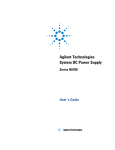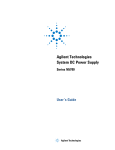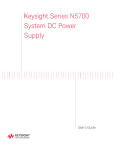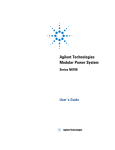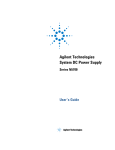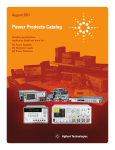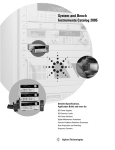Download Agilent Technologies 6552A Specifications
Transcript
10 Practical Tips You Need to Know About Your Power Products Simple ways to improve your operation and measurement capabilities Use remote sensing to compensate for load-lead effects Tip 1 When your power supply leaves the factory, its regulation sense terminals are usually connected to the output terminals. This limits the supply’s voltage regulation abilities, even with very short leads. The longer the leads and the higher the wire gauge, the worse the regulation gets (Figure 1). Compare the output impedance of a well-regulated 10 A supply, which might have an output impedance of 0.2 mΩ, with the resistance of copper wire: I3 0.015 Ω lead resistance + +S Power supply programmed for 5 V, 10 A 5V Load 4.7 V –S – 0.015 Ω lead resistance Load leads are 6 foot, AWG 14 0.015 Ω lead resistance + +S 5.3 V –S – I2 0.015 Ω lead resistance Load leads are 6 foot, AWG 14 Figure 2: Using remote sensing to correct the lead-load problem 2 Load Resistance in mΩ/ft (at 20° C) 22 20 18 16 14 12 10 16.1 10.2 6.39 4.02 2.53 1.59 0.999 And regulation gets even worse if you use a relay to connect power to the load. T3 Remote sensing, in which you connect the sense terminals of the power supply’s internal feedback amplifier directly to the load, lets the power supply regulate its output at the load terminals, rather than at its own output terminals (Figure 2). The supply voltage shifts as necessary to compensate for the resistance of the load leads, relays, or connectors, thereby keeping the voltage at the load constant. To implement remote sensing, disconnect the local sense leads from the output terminals. Use twisted two-wire shielded cable to connect the power supply sensing terminals to the sense points on the load. (Don’t use the shield as one of the sensing conductors.) Connect one end of the shield to ground and leave the other end unconnected. Figure 1: The effects of six feet of AWG 14-gauge leads without remote sensing Power supply programmed for 5 V, 10 A AWG wire size 5V Sensing currents are typically less than 10 mA, and as a general rule, you should keep the voltage drop in the sense leads to less than 20 times the power supply temperature coefficient (usually stated in mV/°C). This is easy to achieve with readily available shielded two-wire cable. Increase safety with remote disable feature Tip 2 Remote disable offers a safe way to shut down a power supply to respond to some particular operating condition or to protect system operators (in response to a cabinet door being opened unexpectedly or someone pushing a panic button, for instance). +5 V To microprocessor RI Com DFI From microprocessor Remote inhibit (RI) is an input to the power supply that disables the output when the RI terminal is pulled low (Figure 1). Shorting the normally open switch turns off the supply’s output. You could also use a logic chip with an open collector transistor output instead of the switch. Figure 1 also shows a discrete fault indicator (DFI) that you can use to signal an operator or other components in the system when the power supply detects a user-defined fault. Com Figure 1. Remote inhibit and discrete fault indicator schematic Almost any operating condition can create a DFI signal. For example, to generate a DFI signal when the load draws excessive current, enable the over-current protection (OCP) mode, program the unit to generate a DFI signal when it enters constant current mode, then program the maximum current the load normally draws. If the load current exceeds the maximum, the DFI output goes low, disables the power supply, and informs the operator of the overcurrent condition (or performs another user-defined function), without tying up the system bus or interrupting the system controller. You can daisy chain DFI and RI as shown in Figure 2. If one supply detects a fault, all supplies in the system are disabled. Using this approach, you can chain together an unlimited number of supplies. RI RI Com Com Power supply #1 Power supply #2 DFI DFI Com Com T2 Figure 2. Daisy-chained DFI and RI T1 3 Eliminate noise from low-level measurements Tip 3 Noise in low-level measurements can come from a number of different sources, and it’s easier to eliminate noise than to filter it. Check these noise sources: 1. Power supply Starting with a low-noise supply is naturally a great way to keep noise out of your measurements. Linear power supplies have lower commonmode noise currents and generally operate at low frequency. However, you can use switch-mode supplies successfully if their specifications include a low common-mode current. As a rule of thumb, common-mode current over 20-30 mA is likely to cause trouble. Keep reading for hints on how to minimize the problem. Shield + C – Power supply Load +S –S Shield Figure 1: Minimizing radiated pick-up with twisted shield leads for both output and remote sense leads 4 2. DUT to power supply connections Minimize conducted noise by eliminating ground loops. Ideally, there should be only one connection to ground. In rack systems, where multiple ground points are inevitable, separate the dc distribution path from other conductive paths that carry ground currents. If necessary, float the power supply (don’t connect either terminal directly to ground). Minimize radiated pick-up (both electric and magnetic) by using twisted shielded conductors for the output and remote sense leads. To make sure the shield doesn’t carry current, connect the shield to ground at one end only, preferably the singlepoint ground on the supply (Figure 1). Minimize the power supply’s commonmode noise current by equalizing the impedance to ground from the plus and minus output terminals. Also equalize the DUT’s impedance to ground from the plus and minus input terminals. Magnetic coupling or capacitive leakage provide a return path for noisy ground loop current at higher frequencies. To balance the DUT’s impedance to ground for your test frequencies, use a common-mode choke in series with the output leads and a shunt capacitor from each lead to ground. 3. Current variations to the DUT Rapid changes in the DUT’s current demand cause voltage spikes. To prevent this, add a bypass capacitor close to the load. The capacitor should have a low impedance at the highest testing frequencies. Avoid imbalances in load lead inductance; direct connections to the DUT, such as twisted shielded pair, are your best bet. Tip 4 Use down programming to increase test speed Under light or no load conditions, a power supply’s output capacitor discharges slowly. If you’re using the supply as a static voltage source, this is not problematic, but when you’re making tests at varying voltage levels, slow discharge means slow tests. Down programming circuits in power supplies rapidly decrease the output voltage, reducing discharge times by hundreds of milliseconds. Agilent Technologies power supplies use two types of down programming circuits: Figure 1: A down programming circuit with an FET across the output terminals • In Figure 2, the down programmer lies between the power supply’s positive terminal and a negative source. This configuration pulls the output completely down with no degradation near zero. Some power supplies, such as the Agilent 663xA series, can sink currents equal to their full output current rating. This sink current is programmable, so you can use the supply both as a programmable source and load. • In Figure 1, an FET is placed across the output terminals. Whenever the output voltage is higher than the programmed value, the FET activates and discharges the output capacitor. The FET can sink currents ranging from 10 percent to 20 percent of the supply’s output current rating. The maximum load at low voltages is limited to the On resistance of the FET plus the series monitoring resistor, resulting in a slight degradation of the down programming current near zero volts. Figure 2: A down programmer situated between power supply’s positive output and a negative source 5 Tip 5 Simplify setup with autoranging power supplies With bench and rack space at a premium, having the ability to produce a wide range of voltage and currents with one power supply is beneficial. Applications that require many voltage and current combinations require many power supplies or a very large power supply to span the largest voltage and current combination. For example, a dc/dc converter is tested under several voltage and current combinations at about the same power level. A very basic dc power supply has a rectangular output (Figure 1). It has a maximum voltage setting (Vmax) and a maximum current setting (Imax) with a single maximum power point (Pmax) which equals Vmax * Imax. This creates a rectangular output characteristic. More advanced power supplies have multi-range outputs. For example, a dual-range power supply (Figure 2) has two rectangular output characteristics, each having a different Vmax and Imax. However, both output characteristics have the same Pmax but at two different points. The power supply can switch between the different ranges to satisfy both rectangular output characteristics. Autoranging outputs (Figure 3) satisfy many different voltage and current combinations that are limited by Pmax. The output characteristic follows a constant Pmax curve allowing for several different power curves rated at the same power level, Pmax. Using autoranging outputs simplifies the test setup by eliminating the need for many power supplies. Supplies such as the Agilent N675xA and N676xA have autoranging outputs that help do this and drive the cost of test down. Figure 1: Rectangular output characteristic Figure 2: Dual-range output characteristic 6 Figure 3. Autoranging output characteristic Connect power supplies in series or parallel for higher output Tip 6 + Power supply #1 – EM + Power supply #2 – E1 + Power supply #3 – E2 EL RL Connecting two or more power supplies in series (Figure 1) provides higher voltages, but observe these precautions: Connecting two or more power supplies in parallel (Figure 2) provides higher currents, but again, observe these precautions: • Never exceed the floating voltage rating of any of the supplies. • Never subject any of the power supplies to negative voltages. • One unit must operate in constant voltage (CV) mode and the other(s) in constant current (CC) mode. • The output load must draw enough current to keep the CC unit(s) in CC mode. Program each power supply independently. If two supplies are used, program each one for 50% of the total output voltage. If three supplies are used, program each supply for about 33% of the total output voltage. Set the current limit of each supply to the maximum that the load can safely handle. The Agilent N6700 supplies have a grouping function that virtually parallels outputs. Output channels can be configured or “grouped” to create a single output with higher current and power capability. EL = EM + E1 + E2 Figure 1: Connecting units in series + Power supply #2 – + Power supply #1 – IM Program the current limit of each unit to its maximum value and program the output voltage of the CV unit to a value slightly lower than the CC unit(s). The CC units supply the maximum output current that they have been set to and drop their output voltage until it matches the voltage of the CV unit, which supplies only enough current to fulfill the total load demand. + Power supply – #3 I1 I2 IL RL IL = IM + I1 + I2 Figure 2: Connecting units in parallel 7 R Tip 7 Simplify battery drain analysis with analysis tools To adequately specify the power source for products that exhibit pulsed and dynamic current loading (such as digital cellular phone and hard drives), you need to evaluate both the peak and dc averages current draws. You could use an oscilloscope to monitor a shunt or a current probe, but this approach raises issues with voltage drops, ground loops, common mode noise, space, and calibration. As a simpler and cheaper alternative, use a power supply with built-in measurement capabilities. The Agilent 66300 mobile communications dc sources store up to 4,096 data points at sample intervals from 15 µs to 31,200 s. Like an oscilloscope, they acquire pre- and post-trigger buffer data by crossing a user-set threshold. The Agilent 14565B device characterization software is an automation tool compatible with the 66319/21B or D. These four sources have battery emulation capabilities and work with the software to accurately test today’s communication devices as well as your next generation designs for cell phones, PDAs, Bluetooth™ enabled devices, and wireless LAN access devices. The software features dynamic current characterization (Figure 1), data logging (Figure 2), and CCDF measurements (Figure 3). Figure 1. Waveform capture and analysis using the Agilent 14565B software. Figure 2. Data logging and analysis using the Agilent 14565B software. Figure 3. Complementary cumulative distribution function (CCDF) capture and analysis using the Agilent 14565B software. 8 Tip 8 Characterize inrush current with an ac power source/analyzer The inrush current characteristics of ac-dc switch mode power supplies vary with the turn-on phase of the voltage cycle. Usually, these power supplies have input capacitors that draw high peaks of inrush current as they charge from the rectified ac line at turn-on. Characterizing inrush current versus turn-on phase can provide some important design insights: Bus trigger Output voltage Start up phase of 40 degrees Inrush current Peak current measurement Digitized inrush current data points Figure 1: An inrush current measurement at 40° using Agilent 6800 series ac power source/analyzers • Uncover component stresses • Check to see if a product produces ac mains disturbances that interact with other products connected to the same branch circuit • Select proper fuses and circuit breakers However, this can be a challenging measurement because you have to synchronize the current digitization and peak current measurement with the startup phase of the voltage. Worst case inrush currents occur near the voltage cycle’s peak and when the ac input capacitor of the DUT is fully discharged at startup. Therefore, you must perform tests at incremental voltage startup phases from about 40° to 90° (Figure 1) and let the DUT’s ac input capacitor discharge between tests. A traditional test setup includes an ac source with programmable phase capability and an output trigger port, a digital oscilloscope, and a current probe. However, using an advanced ac power source/analyzer such as the Agilent 6800 series ac power source/analyzers is easier because they have built-in generation, current waveform digitization, peak current measurement, and synchronization capabilities that let you perform inrush current characterization without cabling and synchronizing separate instruments. On the dc side, the Agilent N6705A dc power analyzer helps characterize the power of a device much like the ac power source/analyzer, except for dc power. 9 Tip 9 Use a power supply to measure DUT supply current Accurately measuring DUT supply currents above 10 A is beyond the range of the typical DMM in ammeter mode. You could use an external shunt and the DMM’s voltage mode, but using the power supply itself is a better solution. Many supplies include an accurate measurement system, including a shunt. Current (with the internal shunt) or voltage measurements at the DUT can be as simple as sending a MEAS command to the power supply. The following table shows the level of measurement accuracy you can expect with a good-quality supply: Output level Typical accuracy Full 10% of full output 1% of full output 0.1% to 0.5% 0.5% to 1% near 10% While the advantages of using the power source to measure high currents is clear, using it to measure low currents may not be as obvious. A system DMM has 0.01 percent to 0.1 percent accuracy, although this doesn’t include other possible errors that can affect the measurement, such as cabling. In contrast, the power supply accuracy figures in the table include all applicable factors. 10 A good system DMM can measure current down to the picoamp level, but you rarely need to measure DUT supply currents this low. In most cases, the toughest measurement will involve current draw by a battery-powered device in sleep mode (such as a cellular phone), where measuring 1-10 mA with reasonable accuracy is usually all you need. Most power supplies’ current readback performs well between full scale and 10% of full scale. You can also choose a power supply with multiple range readback. For example, power sources, such as the Agilent N676xA precision modules, offer full scale accuracy of 0.04% + 15 µA at low range (100 mA) or 0.04% + 160 µA at high range (3 A). Create dc power waveforms with list mode Tip 10 Instead of using a DAC or arbitrary waveform generator to drive a power supply to create dc power waveforms, consider using a single power product with list mode. List mode lets you generate complex sequences of output changes with rapid, precise timing which may be synchronized with internal or external signals. They contain up to 512 individually programmed steps and can be programmed to repeat themselves. Using list mode helps you create dc power waveforms such as: • Pulse trains • Ramps • Staircases • Low frequency sinewaves with dc offset • Arbitrary voltage and current waveforms You can create a sequence of up to 512 command steps to define voltage or current steps and set dwell times for each step. These waveforms can also trigger on internal or external events and be repeated (Figure 1). Once the list of commands is stored in the power supply, the entire list is executed by a single command. This reduces command processing time and simplifies code. Example applications include powering power supply rejection ratio test, simulating automotive crank profiles, and generating pulse dropouts. Power products such as the Agilent N675xA and N676x modules in the Agilent N6700 Modular Power System have list mode. The maximum frequency of the waveform is limited by the power module and voltage setting of the test. In addition, the Agilent N6705A dc Power Analyzer is a unique bench product with list mode. You can program arbitrary waveforms directly from the front panel without writing a single line of code. Trigger 0 1 2 3 4 5 List Count = 1 List Count = 2 Figure 1: An arbitrary voltage waveform example with a repeat count of 2. 11 Power products that do more and less demand Agilent Technologies’ “one-box” philosophy means we pack more and more capability into the power products themselves, in some cases giving you a rack’s worth of capability in a single box. By offering more, these products demand less from you—fewer instruments, less rack space, simpler test setups, and lower cost of ownership. Modular Power Systems (MPS) With rack space at a premium, the Agilent 66000 and N6700 modular power systems’ growing popularity is no surprise. Mix and match modules to fit the needs of many applications. These systems are small, flexible, and fast. 66000 MPS • High power density – up to eight supplies in seven inches of rack space • Low noise, stable power • High accuracy programming and readback N6700 MPS • Up to four supplies in 1.25 inches of rack space • Flexible – three performances: basic, hi-perf, and precision modules • Easy connectivity – LXI Class C with GPIB, LAN, and USB The Agilent N6705A is the bench version of the N6700. It uses the same modules as the N6700 and combines the functionality of many instruments for dc power characterization. • Feature rich – up to 4 supplies, oscilloscope-like display, arb capabilities • Output synchronization controls, inrush current testing, data logging • External BNC and digital port for easy triggering Modular power systems Model Output ratings at 40° C Output voltage Output current Maximum power 66101A 66102A 66103A 66104A 66105A 66106A 0 to 8 V 0 to 16 A 128 W 0 to 20 V 0 to 7.5 A 150 W 0 to 35 V 0 to 4.5 A 157.5 W 0 to 60 V 0 to 2.5 A 150 W 0 to 120 V 0 to 1.25 A 150 W 0 to 200 V 0 to 0.75 A 150 W Basic Models Output ratings at 40° C Output voltage Output current Maximum power N6731A/41A N6732A/42A N6733A/43A/73A N6734A/44A/74A N6735A/45A/75A N6736A/46A/76A 5V 10 A/20 A 50 W/100 W 8V 6.25 A/12.5 A 50 W/100 W 20 V 2.5 A/5 A/15 A 50 W/100 W/300 W 35 V 1.5 A/3 A/8.5 A 52.5 W/105 W/300 W 60 V 0.8 A/1.6 A/5 A 50 W/100 W/300 W Hi-Perf, Precision Models Output ratings at 40° C Output voltage Output current Maximum power N6751A/52A N6753A** N6754A N6761A/62A * 50 V 5 A/10 A 50 W/100 W 20 V 50 A 300 W 60 V 20 A 300 W 50 V 1.5 A/3 A 50 W/100 W * Precision power supplies ** Module not compatible with the N6705A. 12 100 V 0.5 A/1 A/ 3 A 50 W/100 W/300 W Power you can count on year after year We’ve been a leader in the power products business for more than half a century because engineers like you know they can count on Agilent performance, reliability and value. Even our least-expensive dc supplies offer low ripple and noise with tight load and line regulation. Our high precision products give you the exact power levels you need, with accurate readback measurements to match. Plus, every product you see here is covered by a one-year warranty. Single-output dc supplies These supplies will clean up your ATE power without cleaning out your budget. Not only do you buy more performance with the Agilent 6600 or N5700 series, their one-box integration means you’ll buy less equipment overall, too. • Clean, reliable dc power from 40 W to 6.6 W • Designed for fast, easy system integration • Built-in V & I readback for one-box convenience • LXI Class C N5700 supplies with GPIB, LAN, and USB To learn more about these power solutions, visit our Web site at www.agilent.com/find/power. Single-output dc supplies 40 W and 100 W Voltage Current 200 W Output voltage Output current (40° C) 500 W Output voltage Output current (40° C) 750 W 1.5 kW Output voltage Maximum current (40°C) 750 W (continued) 1.5 kW (continued) Output voltage Maximum current (40°C) 2 kW Output voltage Output current 5 kW Voltage Current 6612C 6632B 6633B 6634B 0 to 20 V 0 to 2 A 0 to 20 V 0 to 5 A 0 to 50 V 0 to 2 A 0 to 100 V 0 to 1 A 6541A* 6641A 6542A* 6642A 6543A* 6643A 6544A* 6644A 6545A* 6645A 0 to 8 V 0 to 20 A 0 to 20 V 0 to 10 A 0 to 35 V 0 to 6 A 0 to 60 V 0 to 3.5 A 0 to 120 V 0 to 1.5 A 6551A* 6651A 6552A* 6652A 6553A* 6653A 6554A* 6654A 6555A* 6655A 0 to 8 V 0 to 50 A 0 to 20 V 0 to 25 A 0 to 35 V 0 to 15 A 0 to 60 V 0 to 9 A 0 to 120 V 0 to 4 A N5741A ** N5761A ** N5742A ** N5762A ** N5743A N5763A N5744A ** N5764A ** N5745A N5765A N5746A ** N5766A ** 0 to 6 V 100 A / 180 A 0 to 8 V 90 A / 165 A 0 to 12.5 V 60 A / 120 A 0 to 20 V 38 A / 76 A 0 to 30 V 25 A / 50 A 0 to 40 V 19 A / 38 A N5747A N5767A N5748A ** N5768A ** N5749A N5769A N5750A N5770A N5751A N5771A N5752A ** N5772A ** 0 to 60 V 12.5 A / 25 A 0 to 80 V 9.5 A / 19 A 0 to 100 V 7.5 A / 15 A 0 to 150 V 5 A / 10 A 0 to 300 V 2.5 A / 5 A 0 to 600 V 1.3 A / 2.6 A 6571A* 6671A 6572A* 6672A 6573A* 6673A 6574A* 6674A 6575A* 6675A 0 to 8 V 0 to 220 A 0 to 20 V 0 to 100 A 0 to 35 V 0 to 60 A 0 to 60 V 0 to 35 A 0 to 120 V 0 to 18 A 6680A 6681A 6682A 6683A 6684A 0 to 5 V 0 to 875 A 0 to 8 V 0 to 580 A 0 to 21 V 0 to 240 A 0 to 32 V 0 to 160 A 0 to 40 V 0 to 128 A 6690A 6691A 6692A 0 to 15 V 0 to 440 A 0 to 30 V 0 to 220 A 0 to 60 V 0 to 110 A (40° C, then derated linearly 1%/° C to 55° C) 6.6 kW Voltage Current (40° C, then derated linearly 1%/° C to 55° C) * Economy versions with identical specifications, but without GPIB. ** Supply is rated at the voltage and current combination – may be higher or lower than indicated. 13 Power products that do more and demand less Dynamic measurement dc supplies Solar array simulator (SAS) Electronic Loads The Agilent 66300 series are the first power supplies with instantaneous peak measurement capability, so you no longer need a scope or high-speed digital voltmeter to test devices that draw pulsed current. The Agilent E4350-series SAS simulates the output characteristics of a satellite’s solar panels. It’s also a great example of our ability to create unique power solutions to meet unique application challenges. • Ideal for testing wireless and battery powered products • Superior output transient performance* • Programmable output resistance* • 14565B device characterization software for battery drain analysis* • Simulate I-V curves of a solar array under various conditions • Operate the system in three different modes for maximum flexibility • Have fast recovery time Agilent’s integrated electronic loads help you save time, money, and rack space while delivering precise control and all the capabilities you need for analyzing dc power sources and devices. Use the programmable pulse waveform generator or use analog programming to simulate real-life load conditions. • Ideal for evaluating dc power sources and power components • Lower costs while improving ease of use and test quality • Single-input and modular units with proven record of reliability Dynamic measurement dc supplies Model Voltage Current Maximum power Solar array simulator 66332A 66319B/D 66321B/D E4350B E4351B 0 to 20 V 0 to 5 A 100 W 0 to 15 V 0 to 3 A 45 W 0 to 15 V 0 to 3 A 45 W 0 to 65 V 0 to 8 A 480 W 0 to 130 V 0 to 4 A 480 W Electronic Loads Model Input voltage Input current Max. current derated linearly below 2 V Maximum power 14 6060B, N3304A 6063B, N3303A N3302A N3306A N3305A N3307A 0 to 60 V 0 to 60 A 0 to 240 V 0 to 10 A 0 to 60 V 0 to 30 A 0 to 60 V 0 to 120 A 0 to 150 V 0 to 60 A 0 to 150 V 0 to 30 A 300 W 250 W 150 W 600 W 500 W 250 W ac power source/analyzers From avionics to uninterruptible power supplies, customers are demanding products that can use power efficiently while handling all kinds of ac line disturbances. To make sure your products meet these growing expectations, test them with the Agilent 6800-series ac power source/analyzers. • The fast, easy way to generate both clean and distorted ac power for product testing • A complete solution in a single, compact, tightly integrated box with graphical user interface • Built-in 16-bit power analyzer precisely measures all important parameters • dc output voltage capability of ±425 V (derated power) ac Power Source/analyzers Model 6811B 6812B 6813B Max power # of phases 375 VA 1 750 VA 1 1750 VA 1 Rms output voltage Rms output current 0 to 300 V 0 to 3.25 A 0 to 300 V 0 to 6.5 A 0 to 300 V 0 to13 A For more information, visit our Web site at www.agilent.com/find/power. 15 Agilent Email Updates www.agilent.com/find/emailupdates Get the latest information on the products and applications you select. Agilent Direct www.agilent.com/find/agilentdirect Quickly choose and use your test equipment solutions with confidence. Agilent Open www.agilent.com/find/open Agilent Open simplifies the process of connecting and programming test systems to help engineers design, validate and manufacture electronic products. Agilent offers open connectivity for a broad range of system-ready instruments, open industry software, PC-standard I/O and global support, which are combined to more easily integrate test system development. www.lxistandard.org LXI is the LAN-based successor to GPIB, providing faster, more efficient connectivity. Agilent is a founding member of the LXI consortium. You’re trying to get the most from your power products and get the best power products for your money—and this booklet is a great place to start. You’ll find 10 easy and practical ways to improve power generation and measurement, along with a brief look at our most popular power instruments and systems. For more information, visit our Web site at www.agilent.com/find/power. Remove all doubt Our repair and calibration services will get your equipment back to you, performing like new, when promised. You will get full value out of your Agilent equipment throughout its lifetime. Your equipment will be serviced by Agilent-trained technicians using the latest factory calibration procedures, automated repair diagnostics and genuine parts. You will always have the utmost confidence in your measurements. Agilent offers a wide range of additional expert test and measurement services for your equipment, including initial start-up assistance onsite education and training, as well as design, system integration, and project management. For more information on repair and calibration services, go to: www.agilent.com/find/removealldoubt www.agilent.com For more information on Agilent Technologies’ products, applications or services, please contact your local Agilent office. The complete list is available at: www.agilent.com/find/contactus Americas Canada Latin America United States (877) 894-4414 305 269 7500 (800) 829-4444 Asia Pacific Australia China Hong Kong India Japan Korea Malaysia Singapore Taiwan Thailand 1 800 629 485 800 810 0189 800 938 693 1 800 112 929 81 426 56 7832 080 769 0800 1 800 888 848 1 800 375 8100 0800 047 866 1 800 226 008 Europe Austria Belgium Denmark Finland France Germany 0820 87 44 11 32 (0) 2 404 93 40 45 70 13 15 15 358 (0) 10 855 2100 0825 010 700 01805 24 6333* *0.14 /minute Ireland 1890 924 204 Italy 39 02 92 60 8484 Netherlands 31 (0) 20 547 2111 Spain 34 (91) 631 3300 Sweden 0200-88 22 55 Switzerland (French) 41 (21) 8113811(Opt 2) Switzerland (German) 0800 80 53 53 (Opt 1) United Kingdom 44 (0) 118 9276201 Other European Countries: www.agilent.com/find/contactus Revised: May 7, 2007 Product specifications and descriptions in this document subject to change without notice. © Agilent Technologies, Inc. 2007 Printed in USA, September 21, 2007 5965-8239E Agilent Technologies
















